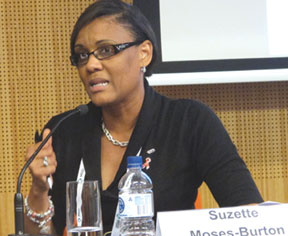 Toward a cure for HIV: The promise of the ‘Mississippi baby’
Toward a cure for HIV: The promise of the ‘Mississippi baby’
By Linda Villarosa Special to the NNPA from The Black AIDS Institute
MELBOURNE, Australia – Is the glass half empty – or half full? That was the framework for thinking about the so-called Mississippi baby case last week at the International AIDS conference here.
The glass was decidedly half empty earlier this month with the news that the baby, thought to have been cured of HIV, had rebounded with detectable levels of the virus in her blood. Quick as a heartbeat, cure was downgraded to remission.
But today in the convention hall, the glass was much more full – or at least the spin was clearly positive. At a special press event, “Toward an HIV Cure,” a group of scientists insisted that the case of the baby, now a little girl, was less a set-back than a way forward. The gathering at the media event also pointed to several new studies that offered information that might lead to hope for a cure.
“There is plenty of data that are telling us that we can make progress,” said Francoise BarreSinoussi of the research. She is a Nobel-prize winning scientist and co-chair of the conference. “There is no reason not to be optimistic.”
Even the virologist involved with the Mississippi baby, Dr. Deborah Persaud, associate professor of pediatrics and infectious diseases at Johns Hopkins Children’s Center, called her case “a major step forward.” After all, the time the baby’s virus stayed under control without treatment was significantly longer than ever witnessed before. The Mississippi infant remained virus-free for 27 months.
“I want to emphasize while we are very disappointed for this child that now requires anti-retroviral treatment to control her virus, this is really unprecedented for the field,” Dr. Persaud said.
The baby was born prematurely in a Mississippi clinic to an HIV-positive mother in 2010. Her mother didn’t receive anti-HIV medication during pregnancy and didn’t know she had contracted the virus until delivery. Right after birth, the infant was treated aggressively and continued on medication until 18 months of age, when doctors lost contact with mother and child. But when the child was again seen by medical staff five months later, they could find no trace of HIV – and she remained virtually free of the virus for more than two years.
But by the time the child turned four, the HIV had returned and the preschooler is now back on medication. Dr. Steven Deeks sees the value in her case. “As a scientist, failures are often more important than successes,” explained Dr. Deeks, an HIV/AIDS researcher and professor of medicine at the University of California, San Francisco. “So I actually perceive the Mississippi baby scientifically as a great success.”
The three new studies out-lined at the press event produced mixed results, though the glass-half-full scientists in Melbourne focused on the “the teaching moments.” All of the studies, including the Mississippi case, point to a latent reservoir of HIV that makes the devious virus hard to com-bat.
One study, conducted on
monkeys, found that HIV reservoirs form even before the virus can be detected in the blood. There, according to investigators at Beth Israel Deaconess Medical Center (BIDMC), HIV can lie dormant and avoid being killed off by anti-AIDS medication. The study was published on July 20 in the science journal Nature.
The second study examined the size of the reservoir using a novel measure. And the third, looked at a drug to kick or shock the virus out of the reservoir where it can hide. This study, released last week and conducted at Aarhus University Hospital in Denmark, excited the audience – though the lead researcher Ole Schmeltz Sogaard called his work “a small step.” At this point no one is sure how to kill the virus once it’s kicked out into the open.
Dr. Deeks disagreed. “Ole’s data is the first clear evidence that we can truly indentify the latent reservoir, the hidden virus, and shock it out of its latency,” he said. “That is the single most important advancement at this meeting and will have a huge impact for the future.”
Earlier in the day, at the morning plenary, titled “Where Are We Now,” Dr. Jintanat Ananworanich offered another modest nod toward the promise of a cure. “There are many novel therapies being studied now to help eliminate cells that are capable of producing virus,” said Dr. Ananworanich, an HIV researcher who works out of Bangkok. “They will help pave the way for what the future will look like. Although there are many challenges, the field is energized.”
Ultimately, as the race for a cure continues, prevention re-mains the best hope. Also speaking at the morning event, Dr. Salim Abdool Karim stressed that we must control the epidemic in the absence of a cure. “Look at the tools we have today for prevention, we can make a huge impact.” He then ticked them off:
The scale up of anti-retroviral treatment;
The further roll out of circumcision;
The provision of anti-AIDS medication very early in every-body who is identified with HIV and The use of anti-retroviral for PreP.
“We can make a huge impact,” continued Dr. Karim, a professor of clinical epidemiology at Columbia University Mailman School of Public Health, “if we are willing to do what it takes to implement the technologies and tools that we have available today.”
Lost among the science is the Mississippi baby herself, an African-American child? Though we don’t know her name, she may be one of the true heroes of the story – whenever it ends. Down the road she may prove to be a more transparent version of Henrietta Lacks, the African-American woman whose cancer tissue was used for research and resulted in a number of medical breakthroughs. Said Dr. Deeks about the Mississippi baby: “Hopefully one day she will know how important she was.”
